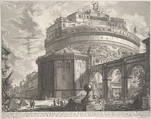View of the Mausoleum of the Emperor Hadrian (now called Castel S. Angelo) from the rear, from Vedute di Roma (Roman Views)
Giovanni Battista Piranesi Italian
Publisher Bouchard & Gravier Italian
Not on view
Piranesi's earliest views of Rome, such as the Piazza del Popolo (37.45.3.49), had placed the principal buildings at the back of a vast, tilted space, filled with a diversity of human activity. By the mid-1750s, the monuments fill the space more commandingly, and are seen as if from below and close at hand, as in this view of the Castel Sant'Angelo. Piranesi produced this view at the same time he was working on the Antichità Romane (41.71.1.3.49; 41.71.1.3.53), his four-volume archaeological treatise, and it may have been originally intended for that work. The clear didactic character of the image and the type of lettering are characteristic of the Antichità Romane, although the dramatic view of the castle as it appeared in the eighteenth century is entirely in keeping with the other Vedute. The buildings at the top of the structure served as a gracious and well-fortified refuge for the pope in times of trouble—the corridor that stretches to the right atop huge arches leads all the way to the Vatican Palace.
This image cannot be enlarged, viewed at full screen, or downloaded.
This artwork is meant to be viewed from right to left. Scroll left to view more.




